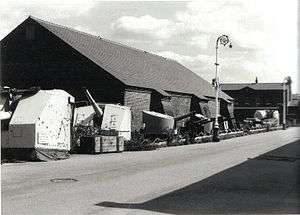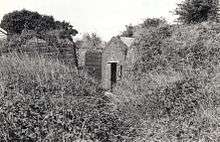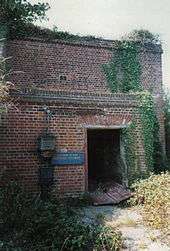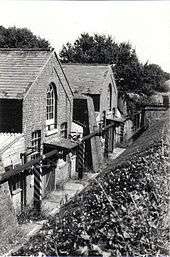Priddy's Hard
Priddy's Hard is an area of Gosport, in Hampshire, England now being developed for housing with part of the site retained as a museum. However, for some two hundred years it was a restricted-access site; first becoming a fort and then an armaments depot for Royal Navy and British Army weapons, explosives and other stores.

History
Priddy's Hard Fort
In 1750 by an Act of King George III the Board of Ordnance purchased 40 acres (16 ha) of agricultural land in Gosport and a boatyard from Jane Priddy and Fareham Vicar, Thomas Missing. This was to construct an earthen rampart as part of an extension of the defences of Portsmouth Harbour and the Royal Dockyard, the Gosport Lines. The ramparts were completed in 1757 and the land enclosed known to as Priddy's Hard Fort; it was manned by the Army. In the nineteenth century Priddy's Hard Fort was armed with 14 eighteen pounder guns.
Ordnance Depot and Royal Laboratory
In 1764, after a series of petitions sent to the Master General of Ordnance from the general public, the decision was made to remove the gunpowder that had been stored in Square Tower, Portsmouth.
First. In carrying powder from thence to the hoys about 400 yards (367 m) distance to the end of the point, and by shaking the barrels together in a Cart there has been a train along that street, which in War time is the most popular part of the town.Second. When funerals pass by there the sparks of the Links and Torches have been seen to fly against the Magazine Walls and Windows.
Third. At shipping off the Powder from the Point among a crowd of drunken, smoking, sailors tending to the Men of Wars boats is also a very great hazard.
Fourth. This Magazine being next to the sea and within reach of Shipping, makes it a good Mark to Bombard where 6,000 barrels (950 m3) of Powder are lodged.
5th. When Spring Tides come into the Ground Room under the Foundation of the Wall, and strike up damps, which might be cured by Arching over that places; but since the other inconveniences are so great to cause the Ruin of this Place and from miles around: Am humbly of the opinion a New Magazine in the Harbour, free from the said Hazards would be most for the safety of this port.
If the Magazine had exploded the casualties would have been appalling in this densely populated part of Portsmouth. Serious accidents with gunpowder were well known, some of them were recorded as follows:
- 1649, Tower Street, London — 60 houses demolished after 37 barrels detonated in a shop.
- 1654, Gravelines — explosion of magazine, 3,000 killed.
- 1693, Dublin — detonation of 218 barrels, 100 killed.
- 1739, Brescia — lightning strike, 3,000 killed.
Various proposals were suggested as to where to build the new gunpowder magazine, Priddy's Hard, Boatswain's Hill Coppice (where Defence Munitions Gosport is today), and Horsea Island in the eastern reaches of Portsmouth Harbour. None of the sites were considered ideal, including Priddy's Hard, the main concern the closeness of the Royal Dockyard, this would eventually lead to its final closure.
Priddy's Hard was chosen due to the availability of the land (already owned by the Crown) and in December 1766 the decision was finally made by the Ordnance Board and the First Lord of the Admiralty.
Originally the magazine was to be loaded from a rolling-way across the foreshore but it was decided when the time came, to construct a camber basin to enable the lighters to unload right at the rear of the magazine. Further magazines were planned at this juncture to the east and west of the current Grand Magazine, but were never built. This lack of storage capacity was highlighted during the Napoleonic Wars and as a consequence led to the use of floating gunpowder in the reaches of Fareham Lake.

Construction of the new powder magazine on land within the ramparts commenced in 1771, along with a cooperage, guardhouse, shifting house barracks and the octagonal camber basin. The Grand Magazine (as it became) was originally enclosed with a high brick wall to assist with security and to ensure no contraband items were brought into the magazine. These items included ferrous objects (to reduce the risk of sparks), alcohol and smoking materials.
Board of Ordnance2 May 1777
Gentlemen,
The Board direct that the labourers at the Gun Wharf at Portsmouth assist in removing the Powder from the Town Magazine, and in unloading and stacking the same in the Magazine at Priddy's Hard, this they are to continue to do when business at the Gun Wharf will permit.
Access to the Grand Magazine by hoys (lighters) was a problem from the very beginning. Although the camber basin was constructed with a sluice to help prevent silting up, vessels still had difficulty entering it at any other time than high tide. This problem was solved by the construction of a pier on the eastern side of the camber basin, the remains of which can be seen at low water.
By May 1777, the first powder barrels were moved to Priddy's Hard from Portsmouth's Square Tower. Although six thousand barrels of gunpowder could be stored there, it was subsequently thought necessary to disperse the ammunition and gunpowder in case the depot ever came under attack. Satellite magazine stores were built to serve this purpose in other locations, but Priddy's Hard remained the most important.
Why it took six years for all of the complex to be completed is not known. The addition of a further two magazines flanking either end and at right angles to the Grand Magazine were cancelled. A possibility for the cancellation may have been the serious fire in the Portsmouth Royal Dockyard in 1776.
Nineteenth century complex


By 1846 Priddy's Hard was still under the control of the Board of Ordnance and the following building existed on the site:
- Powder Magazine — Built to store 6,222 100 lb barrels. Contained an office for the Foreman, Shoehouse and Pumphouse.
- Two Shifting Houses — For civilian workers and Army guards.
- Inner and Outer Rolling Way to the Magazine.
- Connecting Store.
- Camber Basin.
- Four Demi-Bastions.
- Three Storehouses.
- Two Fire Engine Houses.
- Boathouse.
- Guardhouse.
- Ferryman Lodge (demolished in 1960s).
- House for Works Overseer (demolished in 1950s).
- Houses for Storekeepers, Foreman of Labourers, Cooper & Coxswain.
- Apartments for Established Clerk & Office Keeper.
Little Horsea Island laboratory
Laboratory buildings, those that were used for the filling of round shot, paper and flannel charges were built sometime at the end of the nineteenth century on Little Horsea Island. Records exist for the payment of wages of £5 a month "on account of the Royal Powder Works at Little Horsey Island for wages of the cooper, repairing of boats and barges, keep of dogs etc.."
Marchwood and Tipnor Depots
Storage problems at Priddy's Hard were eventually solved by the construction of further magazines at Marchwood in 1815 and Tipnor in 1830.
During the 19th century further magazines and buildings were added including the installation of a narrow gauge railway system across the whole site and the construction of piers on the Harbour. The site was altered continuously during the early 20th century and it was fully utilised during World War I and World War II when thousands of women workers filled jobs vacated by men on active service.
Main nineteenth century buildings constructed



- 1848 - First Royal Laboratory Complex (Including Office Building and Officer's Quarters.
- 1861 - "C" Powder (60 Tons) Magazine.
- 1866 - Six Shell Filling Rooms.
- 1879 - "E" Powder (500 Tons) Magazine.
- 1886 - Shell Filling Rooms.
- 1887 - Unheading Room.
- 1888 - Shell Filling Room.
- 1889 - QF Cartridge Storehouse.
- 1898 - QF Cartridge Storehouse.
- 1900 - Proof House.
- 1900 - QF Cartridge Storehouse.
- 1900 - Dry Guncotton (50 Tons) Magazine.
- 1900 - Wet Guncotton (360 Tons) Magazine.
- 1901 - Mine Storehouse & Exam Rooms.
- 1900 - 1906 - Cordite Magazines 454, 357 & 358.
- 1901 - Twelve Cartridge Rooms.
- 1902 - Room for the Conversion of Dangerous Ammunition.
- 1904 - Shell Emptying Room.
Priddy's Hard Tramway
Priddy's Hard ordnance depot had an 18 in (457 mm) gauge tramroad railway for moving ammunition around, from mid 19th century to the 1900s. It was a single line system with spurs into all magazines, explosives stores, cartridge filling rooms, and landing sheds. It extended out on the New Powder Pier in a double line. The rails were made of delta metal, an alloy of copper and zinc, (brass) plus a little iron, as a precaution against sparks. A remnant of the line behind store N.372 shows it had grooved rails set flush with ground level. In 1904 it had 78 trucks. It was superseded by the 2 ft 6 in (762 mm) narrow gauge line; but part continued in use inside some workshops and stores to about 1960.
Decommissioning


Priddy's Hard became the oldest of several depots (including former Ordnance Depots Marchwood, Tipnor Magazine & Dean Hill) now making up the complex of the Royal Naval Armament Depot (RNAD) Gosport, latterly retitled Defence Munitions Gosport.
For many years, Priddy's Hard was both the Royal Navy's and regional Army's armaments depot and supplier of ordnance and training to Commonwealth and Foreign countries, though its significance decreased over time. The site was last used for significant naval activity during the Falklands Conflict in 1982, and was vacated by RNAD Gosport in 1988 when the last remaining stores and staff were relocated.
The site was redeveloped for housing, though some of it was retained for Explosion!, the Museum of Naval Firepower, though the fort ramparts have been left in recent years to become overgrown and often set alight by vandals. The former laboratory buildings (some of which were to be retained for historical reasons), known by workers as the "Happy Valley", within the ramparts and moat, have now been burnt to the ground and beyond repair.
A new Millennium bridge from Gosport town centre was constructed to aid the redevelopment and access to the area. However, by April 2007, the Museum was proving too costly to run and was limited to weekend opening (and weekdays for pre-booked school parties).
See also
- Explosion! Museum of Naval Firepower, a museum located at Priddy's Hard
- Gunpowder Magazines in England
- Priddy (disambiguation)
- Hard (nautical)
References
- H.W. Semark (1997). The Royal Naval Armament Depots of Priddy's Hard, Elson, Frater and Bedenham (Gosport, Hampshire) 1768 to 1997. Winchester: Hampshire County Council. (2nd Edition, 1998: ISBN 1-85975-132-6).
- W.N. Mansfield (1994), RNAD Priddy's Hard 1846 – 1906. Research Report.
- W.N. Mansfield (1995), "Priddy's Hard 1846 – 1906 — The site impact of the introduction of modern chemical explosives". BSc (Hons) Archaeology dissertation.
External links
![]() Media related to Priddy's Hard at Wikimedia Commons
Media related to Priddy's Hard at Wikimedia Commons
Coordinates: 50°48′24″N 1°7′32″W / 50.80667°N 1.12556°W